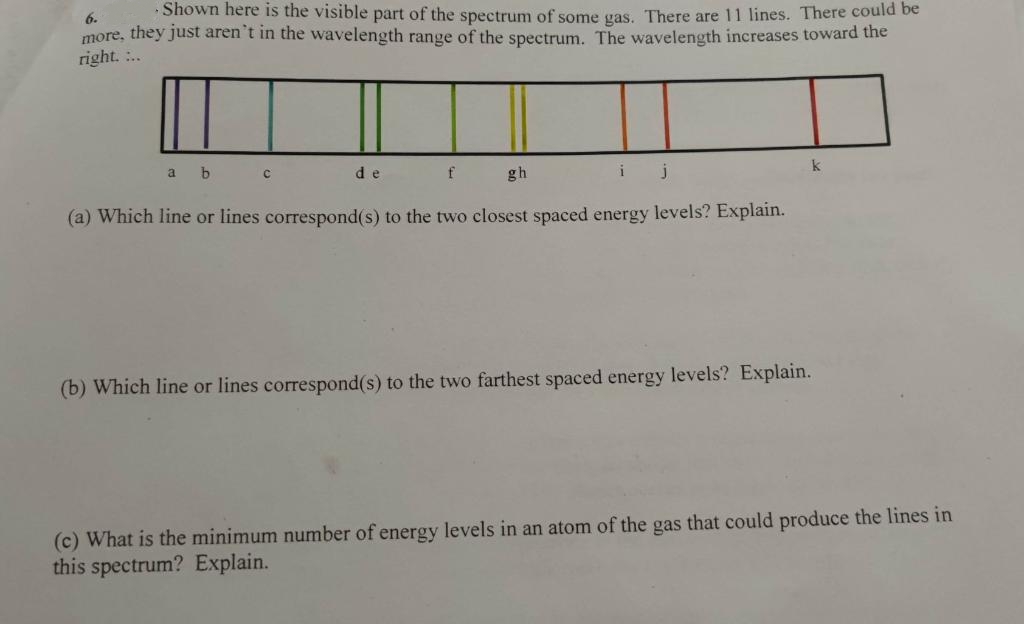Shown here is the visible part of the spectrum of some gas. There are 11 lines. There could be 6. more, they just aren't in the wavelength range of the spectrum. The wavelength increases toward the right. :.. a b de gh i (a) Which line or lines correspond(s) to the two closest spaced energy levels? Explain. (b) Which line or lines correspond(s) to the two farthest spaced energy levels? Explain. (c) What is the minimum number of energy levels in an atom of the gas that could produce the lines in this spectrum? Explain.
Shown here is the visible part of the spectrum of some gas. There are 11 lines. There could be 6. more, they just aren't in the wavelength range of the spectrum. The wavelength increases toward the right. :.. a b de gh i (a) Which line or lines correspond(s) to the two closest spaced energy levels? Explain. (b) Which line or lines correspond(s) to the two farthest spaced energy levels? Explain. (c) What is the minimum number of energy levels in an atom of the gas that could produce the lines in this spectrum? Explain.
Principles of Physics: A Calculus-Based Text
5th Edition
ISBN:9781133104261
Author:Raymond A. Serway, John W. Jewett
Publisher:Raymond A. Serway, John W. Jewett
Chapter28: Quantum Physics
Section: Chapter Questions
Problem 25P
Related questions
Question

Transcribed Image Text:·Shown here is the visible part of the spectrum of some gas. There are 11 lines. There could be
6.
more, they just aren't in the wavelength range of the spectrum. The wavelength increases toward the
right. :..
de
f
gh
k
(a) Which line or lines correspond(s) to the two closest spaced energy levels? Explain.
(b) Which line or lines correspond(s) to the two farthest spaced energy levels? Explain.
(c) What is the minimum number of energy levels in an atom of the gas that could produce the lines in
this spectrum? Explain.
Expert Solution
This question has been solved!
Explore an expertly crafted, step-by-step solution for a thorough understanding of key concepts.
This is a popular solution!
Trending now
This is a popular solution!
Step by step
Solved in 2 steps with 2 images

Knowledge Booster
Learn more about
Need a deep-dive on the concept behind this application? Look no further. Learn more about this topic, physics and related others by exploring similar questions and additional content below.Recommended textbooks for you

Principles of Physics: A Calculus-Based Text
Physics
ISBN:
9781133104261
Author:
Raymond A. Serway, John W. Jewett
Publisher:
Cengage Learning

Physics for Scientists and Engineers with Modern …
Physics
ISBN:
9781337553292
Author:
Raymond A. Serway, John W. Jewett
Publisher:
Cengage Learning


Principles of Physics: A Calculus-Based Text
Physics
ISBN:
9781133104261
Author:
Raymond A. Serway, John W. Jewett
Publisher:
Cengage Learning

Physics for Scientists and Engineers with Modern …
Physics
ISBN:
9781337553292
Author:
Raymond A. Serway, John W. Jewett
Publisher:
Cengage Learning


College Physics
Physics
ISBN:
9781938168000
Author:
Paul Peter Urone, Roger Hinrichs
Publisher:
OpenStax College

College Physics
Physics
ISBN:
9781285737027
Author:
Raymond A. Serway, Chris Vuille
Publisher:
Cengage Learning

Stars and Galaxies (MindTap Course List)
Physics
ISBN:
9781337399944
Author:
Michael A. Seeds
Publisher:
Cengage Learning